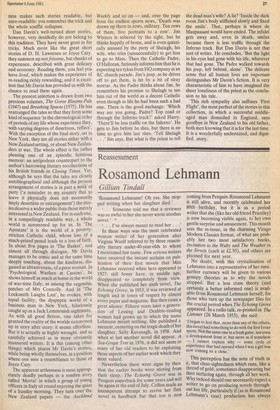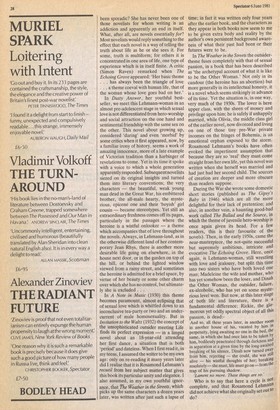Reassessment
Rosamond Lehmann
Gillian Tindall
'Rosamond Lehmann? Oh yes. She stopped writing when her daughter died.'
. . Someone told me that a reviewer was so awful to her she never wrote another novel.' " `. . . I've always meant to read her . . In these ways was the most celebrated woman writer of her generation after Virginia Woolf referred to by three reasonably literary under-40-year-olds to whom I mentioned her name. Few serious writers have received the instant acclaim on publication of their first novels that Miss Lehmann received when hers appeared in 1927; still fewer have, in middle age, disappeared . so completely from view. When she published her sixth novel, The Echoing Grove, in 1953, it was reviewed at length and in tones of respect by almost every paper and magazine. But then came a great silence. Fifteen years later a generation of Lessing and Drabble-reading women had grown up to which the name Lehmann meant nothing. She published a memoir, centering on the tragic death of her daughter, Sally Kavanagh, in 1958. And when at last another novel did appear, A Sea-Grape Tree in 1976, it did not seem to many of her old readers to be exploiting those aspects of her earlier work which they most valued.
Nevertheless there were signs by then that the earlier books were stirring from their sleep. , The Echoing Grove was in Penguin paperback for some years and will be again at the end of July. Collins made an incompetent attempt to revive her first novel in hardback but that too is now coming from Penguin .Rosamond Lehmann is still alive, and recently celebrated her 80th birthday, but it is as a period writer that she (like her old friend Priestley) is now becoming visible again, to her own gentle surprise and amusement. This month sees the re-issue, in the charming Virago Modern Classics format, of what are probably her two most satisfactory books, Invitation to the Waltz and The Weather in the Streets (each at f2.95), and others are planned for next year. No doubt, with this crystallisation of Lehmann into a representative of her time, further currency will be given to various gossipy theories as to why the novels stopped. But a less crass theory (and certainly a better informed one) is available from Rosamond Lehmann herself, for those who turn up the newspaper files for the crucial period when The Echoing Grove appeared. In a radio talk, re-printed in The Listener (26 March 1953), she said:
'I began to feel that, more than any of the others, this novel had something to do with the first I ever wrote. Not the same one in a fresh guise, not even a development from it; but more as if somehow — I cannot explain why — some cycle of experience that had opened when I was a girl was now coming to a close.'
This perception has the note of truth in it, that clear-sightedness which runs, like a thread of gold, sometimes disappearing but then surfacing again, through all her work. Why indeed should one necessarily expect a writer to go on producing novels throughout her life, particularly if (as in Rosamond Lehmann's case) production has always been sporadic? She has never been one of those novelists for whom writing is an addiction and apparently an end in itself. What, after all, are novels essentially for?
Most novelists would reply something to the effect that each novel is a way of telling the truth about life as he or she sees it. For some, truth is multiform; for others it is concentrated in one area of life, one type of experience which is in itself finite. A critic (Simon Raven) remarked when The Echoing Grove appeared: 'Her basic theme . . . has always been the triangle of love . a theme coeval with human life, that of the woman whose love goes bad on her.'
In Dusty Answer, her youthful bestseller, we meet this Lehmann-woman in an almost pre-adolescent stage in which sexual love is not differentiated from hero-worship and social attraction on the one hand and sentimental friendship with the same sex on the other. This novel about growing up, considered 'daring' and even `morbid' by some critics when it first appeared, now, by a familiar irony of history, seems a work of amazing innocence, more of a late example of Victorian tradition than a harbinger of revelations to come. Yet in its time it spoke with a voice to which a whole generation apparently responded. Subsequent novelists siezed on its original insights and turned them into literary conventions; the very characters — the beautiful, weak young man dead in the Great War, his embittered brother, the all-male hearty, the mysterious, epicene one and their 'boyish' girl cousin — became stereotypes. Yet still an extraordinary freshness comes off its pages, particularly in the passages where the heroine is a wistful onlooker — a theme which accompanies that of love throughout the novels. Always, in Lehmann-land, as in the otherwise different land of her contemporary Jean Rhys, there is another more desirable life going on elsewhere, in the house next door, or in the garden on top of the hill, or behind the lighted window viewed from a rainy street, and sometimes the heroine is admitted for a brief space, by virtue of her beauty or some other charm over which she has no control, but ultimately she is excluded . .
In A Note in Music (1930) this theme becomes paramount, almost eclipsing that of sexual love which is whittled down to an inconclusive tea-party or two and an undercurrent of male homosexuality. But in Invitation to the Waltz (1932) the concept of the unsophisticated outsider meeting Life finds its perfect expression — in a limpid novel about an 18-year-old attending her first dance, a situation that is both 'period' and dateless. When I first read it, in my teens, I assumed the writer to be my own age: only on re-reading it many years later did I realise that it is Rosamond Lehmann's recueil from her subject matter that gives this book its particular unity and elegance. I also assumed, in my own youthful ignorance, that The 147e' ailier in the Streets, which picks up the same characters a dozen years later, was written after just such a lapse of time; in fact it was written only four years after the earlier book, and the characters as they appear in both books now seem to me to be given extra body and reality by the author's own persistent background awareness of what their past had been or their futures were to be.
In The Weather in the Streets the outsidertheme fuses completely with that of sexual passion, in a book that has been described as 'the archetypal account of what it is like to be the Other Woman.' Not only in its candour (the heroine has an abortion) but more generally in its intellectual honesty, it is a novel which seems strikingly in advance of its time. Yet the situation is, in one way, very much of the 1930s. The lover is here upper class, with the sheen of money and privilege upon him; he is safely if unhappily married, while Olivia, the middle class girl of the earlier novel, now divorced and living on one of those tiny pre-War private incomes on the fringes of Bohemia, is an emotional orphan exposed to the storm. Rosamond Lehmann's books have often evoked the impertinent assumption that because they are so 'real' they must come straight from her own life, yet this novel was written when she herself was married and had just had her second child. The sources of creation are deeper and more obscure than readers suppose. During the War she wrote some domestic short stories (published as The Gipsy's Baby in 1946) which are all the more delightful for their lack of pretention; and also, in another vein, a haunting good-bad work called The Ballad and the Source, in which the theme of juvenile hero-worship is once again given its head. For a few 'readers, this is their favourite of the novels). Then, in the early 1950s, came the near-masterpiece, the not-quite successful but supremely ambitious, intricate and evocative The Echoing Grove. Here, once again, is Lehmann-woman, still wrestling with love and jealousy, but split this time into two sisters who have both loved one man; Madeleine the wife and mother, who has yet somehow been the loser, and Dinah the Other Woman, the outsider, failure, ex-alcoholic, who has yet on some mysterious level won. But now, at this later stage of both life and literature, there is fundamental difference: Rickie, the glamorous yet oddly spectral object of all this passion, is dead: And so, all these years later, in another roar in another house of his, vacated by him 111 perpetuity, lying awaiting no one in the bed, the same, in which she had once lain to be taken by him, bodilessly penetrated through darkness and in separation at a given time by the long-awaited breaking of his silence. Dinah now turned away from him, rejecting — she could, she was still alive — his wistful thoughts of her; breaking resolutely— she must, life must go on — from the trap of his pursuing shadow. 'Lament no more. These things are so.' Who is to say that here a cycle is not complete, and that Rosamond Lehmann did not achieve what she originally set out to do?











































 Previous page
Previous page